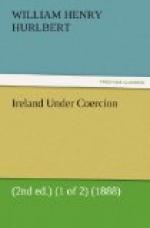The grand gallery of the castle, the finest in the kingdom, though a trifle narrow for its length, is hung with pictures and family portraits. One of the most interesting of these is a portrait of the black Earl of Ormon’de, a handsome swarthy man, evidently careful of his person, who was led by that political flirt, Queen Elizabeth, to believe that she meant to make him a visit in Ireland, and, perhaps, to honour him with her hand. He went to great expenses thereupon. At a parley with his kinsman, the Irish chieftain O’Moore of Abbeyleix, this black earl was traitorously captured, and an ancient drawing representing this event hangs beneath his portrait.
The muniment room, where, thanks to Lord Ormonde’s courtesy, we found everything prepared to receive us, is a large, airy, and fire-proof chamber, with well-arranged shelves and tables for consulting the records. These go back to the early Norrnan days, long before Edward III. made James Butler Earl of Ormonde, upon his marriage with Alianore of England, granddaughter of Edward I. The Butlers came into Ireland with Henry II., and John gave them estates, the charters of some of which, with the seals annexed, are here preserved. There are fine specimens of the great seals also of Henry III., and of his sons Edward I. and Edmund Crouchback, and of the Tudor sovereigns, as well as many private seals of great interest. The wax of the early seals was obviously stronger and better than the wax since used. Of Elizabeth, who came of the Butler blood through her mother, one large seal in yellow wax, attached to a charter dated Oct. 24, 1565, is remarkable for the beauty of the die. The Queen sits on the obverse under a canopy; on the reverse she rides in state on a pacing steed as in her effigy at the Tower of London. The seals of James I. follow the design of this die. Two of these are particularly fine. At the Restoration something disappears of the old stateliness. A seal of Charles II., of 1660, very large and florid in style, shows the monarch sitting very much at his ease, with one knee thrown negligently over the other. Many of the private letters and papers of the seventeenth and early eighteenth centuries, during which Kilkenny, as it had been often before, was a great centre of Irish politics and intrigues, have been bound up in volumes, and the collection has been freely drawn upon by historians. But it would obviously bear and reward a more thorough co-ordination and examination than it has ever yet received.
There is a curious Table Book here preserved of Charles I. while at Oxford in 1644, from which it appears that while the colleges were melting up their plate for the King, his Majesty fared better than might have been expected. His table was served with sixty pounds of mutton a day; and he wound up his dinner regularly with “sparaguss” so long as it lasted, and after it went out with artichokes.




